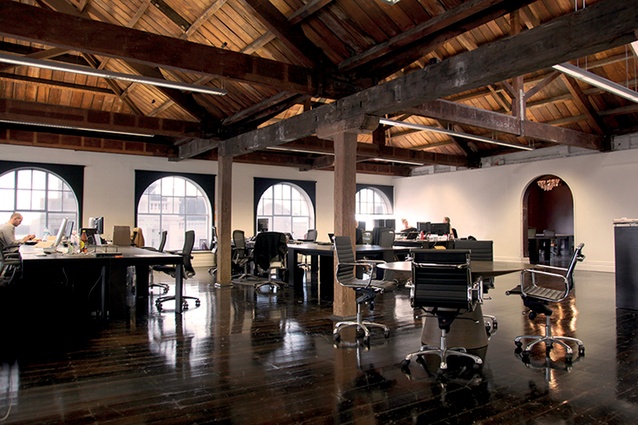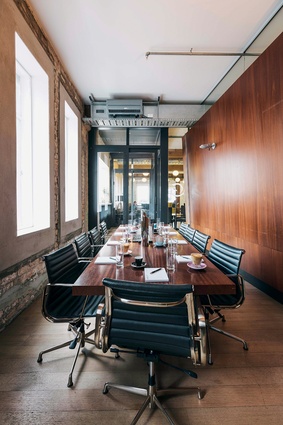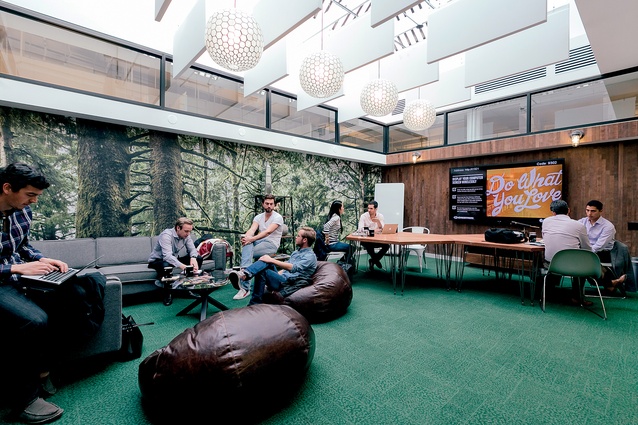Sharing is caring
We’ve come a long way from the offices depicted in the TV series Mad Men. Not only are mid-morning whiskies, never-ending cigarettes and ‘friendly’ bottom pats frowned upon but we have also seen workplaces scaled back from Chesterfield couches and leather-topped desks, to the any-user Activity Based Working office, and the shared space – a user-friendly working hive where (in some cases) tenants can dip in and out as they need to.
According to a Bayleys report released this year called ‘The Evolution of Co-working’, the co-working phenomenon is global and growing exponentially. WeWork is the world leader, having grown from a single Manhattan office in 2010, to a membership of over 50,000 in more than 100 locations in 25 American cities. WeWork has recenty arrived to Australia and is expected to expand its operations across Australasia. Locally, the number of co-working spaces in Auckland has increased from a core of three operators in 2011 with a floor space of 1,400m2, to 13 in 2016 with a total area of 13,800m2.

ColabNZ tops our list, with 5,000m2 over its four shared spaces in Auckland – and one more to come at the end of this year. According to founder Robett Hollis, there is no shortage of companies and individuals who want to use ColabNZ’s services. “Basically people want to get out of their bedrooms and be surrounded by positive individuals who are on the same page. The reality is if you’re in a similar industry, within a day you’re going to figure out whether there is a potential crossover. People want to be inspired by others around them and have fresh ideas rolling.”
ColabNZ has just opened its first North Shore space within The Department Store in Takapuna, a small-scale – you guessed it – department store housing designer retail and beauty outlets. Why put co-working offices in a retail store? “Most of our tenants are digitally focused but with a creative element, like programmers and 3D game developers,” says Hollis.
“The opportunity to put a co-working space in with a Karen Walker store was a no-brainer. It’s about making an ideas house that can be driven around creativity, while using what has already been a winning formula with shared workspaces. Co-working is part of the shared economy. Look at Uber with transportation; Airbnb with accommodation – this is just the shared economy at force in the commercial environment.”

Shared offices have also taken off in Christchurch, where many small companies found themselves isolated since the 2011 earthquakes. The shared space at 190 Asaph Street (winner of the Workplace Up to 1,000m2 award at the 2016 Interior Awards) is a great example of how sharing works on a small scale with just 10 occupants, while companies such as QB Studios operates on a larger scale.
QB has created a series of offices in both Christchurch and Auckland that can house larger, more established companies for longer periods. Co-founder Alex Brennan says QB offers exclusive office studios, rather than open-plan spaces. “Everybody has their own door they can close and lock at the end of the day,” he says. “We have larger companies, such as Designworks, who have offices in Singapore and Australia, right down to companies of just one or two people. Everyone chips into a pool for common resources they may not use all of the time, but need occasionally, such as printers and boardrooms. And they get the use of the larger, open-plan common areas, without having to pay rent for them.”
Despite the fact we have lost the lux of the ’60s, there are cultural perks to these modern offices. QB’s locations double as curated art galleries, which means tenants can benefit from the creative influence of having fresh art around, and, through the bi-monthly exhibition launches, fresh faces with whom to network. Most shared offices also have break-out spaces with everything from coffee machines and bar areas to beanbags and table tennis.

But for start-ups trying to make it big, how is it beneficial to be paying rent for an office when you could be working from your kitchen table (with your stovetop percolator)? Accountability is one answer. Companies such as Greenhouse in Christchurch, which is owned by the Canterbury Development Corporation and housed in Christchurch’s Innovation Precinct, go a little further than just being a shared office space. You must be in the early stages of an ICT or digitally-based business idea to gain a tenancy, and the company offers services to help you on your way, including accountability.
Greenhouse recognises the fast-paced nature of the ICT industry. As quoted on its website, “spend too long in development and the world will pass you by”. The maximum tenancy at Greenhouse is 18 months, and the company treats this like a work contract, setting performance indicators and reviewing progress at six and 12 months of tenancy, with an exit review after 18 months. If you don’t live up to expectations at your reviews, your tenancy will be cancelled. At 18 months, you will be guided into the next step.
With art galleries and designer neighbours, it seems the future of work is about creating something more substantial for the soul than a dry cubicle-filled office space. The future of the workplace isn’t The Office anymore than it is Mad Men, but something more human-centric, where sharing ideas, instigating success, sociability and culture are the drivers.

Interview with Ryan Wilson
Generator
What is the key to creating a successful co-working space?
First-class amenity backed up by a high level of service. Creating spaces for working and socialising that are stimulating, inspiring and meet the functional needs of our members. Diversity is key to our community. Having a mix of different tribes that defines the unique culture within each of our locations and ensuring that we have a team of well-trained staff who carefully curate and nurture that community to ensure it continues to evolve and develop as people come through.
Without a common ‘brand’ or corporate culture holding these individuals together there must be more responsibility on choosing the right tenants. What are the criteria?
Diversity is key. Staff and stakeholders define the personality and values of the community at the outset. We then take a bit of a back step and allow the community to develop its own culture within the framework we have set. Once established, the key thing is to allow that community to morph and change as the mix of people changes. We also have a ‘no-wankers’ policy for a particularly ‘bad apple’ and if the community doesn’t self-police that aspect, we remove the bad apple from the mix… This has only happened twice in five years.
How does the actual design of the space cater for such a variety of industries and people?
We loosely identify five tribes that work out of our spaces and an intimate understanding of each of these is fundamental to creating spaces that meet their respective needs. Music, design, lighting, desk layout and the mix of people within each space are fundamental to success. In addition, quiet zones, little break-out spaces and meeting rooms need to be complemented by buzz zones and social areas that encourage ‘bumpability’ and the chance to enjoy a chat with someone new. Finally, smell, taste and sound need to be consistent so that members recognise they are in their space and it is a Generator.

Interview with Lloyd Budd
Bayleys
How are shared spaces changing the way a company like Bayleys operates?
Co-working and shared spaces are providing a fantastic opportunity for real estate agencies to innovate. Because of the growing demand for these types of spaces, tenants are now regularly comparing ‘typical’ office space to co-working – as a better real estate solution for their business. As a leading agency in understanding our customers’ needs, we have made a big investment in our people to ensure they understand the benefits co-working offers and that the spaces are represented fairly in the options mix.
What do you think are the biggest challenges/hurdles for this model of corporate real estate to take off locally?
There are a few hurdles to overcome – and some that have already been smashed. Co-working as an industry is now recognised by global corporate real estate leaders as a credible solution. The hurdles we face locally at present are: 1. Current vacancy rates are low – therefore there are limited options for suitable space. 2. An understanding of the business model – particularly the upfront capital and start-up occupancy required for success. Essentially this requires a partnership model with some shared risk in the initial months. 3. The industry itself creating its own co-working businesses to capitalise on the demand. Larger overseas operators like WeWork are likely to arrive in New Zealand at some stage.
How do you think local operators can stay ahead of the game?
Firstly, the arrival of WeWork to Auckland would not be a bad thing. In many global markets where they operate, there has been a significant boost in occupancy and rates for the local players. This is because co-working as an industry is very diverse – there are solutions that fit start-ups/tech companies and those that suit larger companies. The flexibility and culture of each space is what creates the community – and therefore the success. Secondly, like the current landlord market – there is room for many different operators here in Auckland. We believe current demand to be more than 60,000m2 for Auckland alone (current supply around 13,500m2).
















